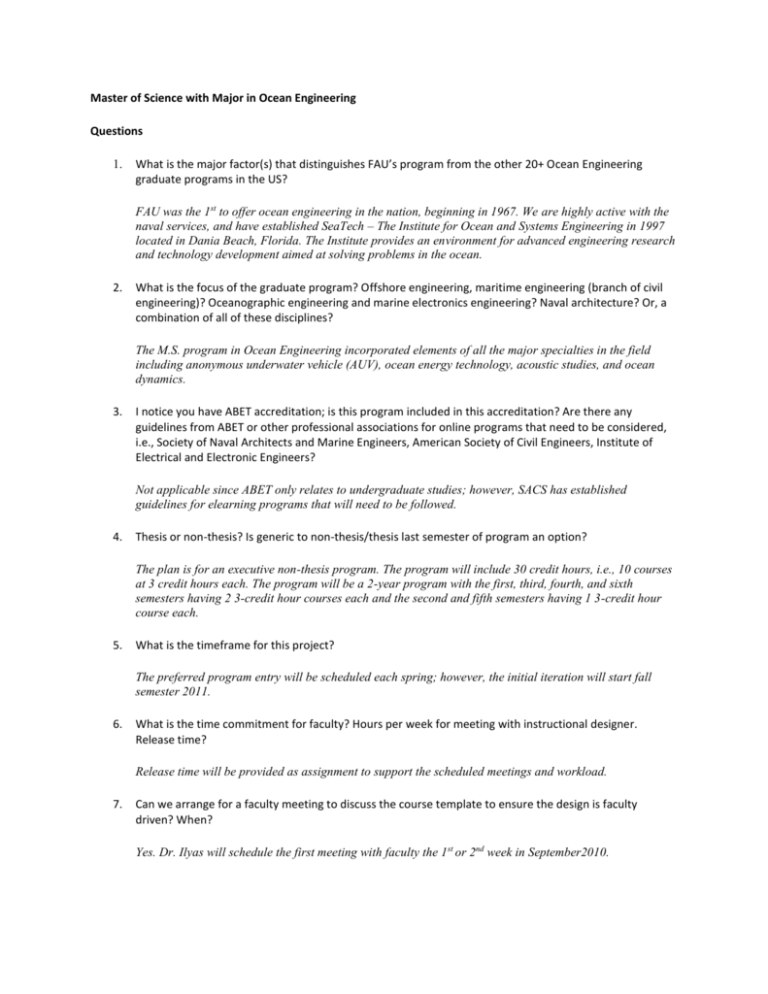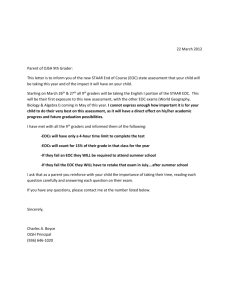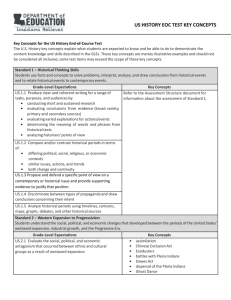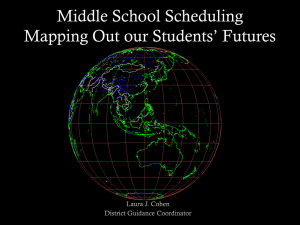Ocean Engineering - Florida Atlantic University
advertisement

Master of Science with Major in Ocean Engineering Questions 1. What is the major factor(s) that distinguishes FAU’s program from the other 20+ Ocean Engineering graduate programs in the US? FAU was the 1st to offer ocean engineering in the nation, beginning in 1967. We are highly active with the naval services, and have established SeaTech – The Institute for Ocean and Systems Engineering in 1997 located in Dania Beach, Florida. The Institute provides an environment for advanced engineering research and technology development aimed at solving problems in the ocean. 2. What is the focus of the graduate program? Offshore engineering, maritime engineering (branch of civil engineering)? Oceanographic engineering and marine electronics engineering? Naval architecture? Or, a combination of all of these disciplines? The M.S. program in Ocean Engineering incorporated elements of all the major specialties in the field including anonymous underwater vehicle (AUV), ocean energy technology, acoustic studies, and ocean dynamics. 3. I notice you have ABET accreditation; is this program included in this accreditation? Are there any guidelines from ABET or other professional associations for online programs that need to be considered, i.e., Society of Naval Architects and Marine Engineers, American Society of Civil Engineers, Institute of Electrical and Electronic Engineers? Not applicable since ABET only relates to undergraduate studies; however, SACS has established guidelines for elearning programs that will need to be followed. 4. Thesis or non-thesis? Is generic to non-thesis/thesis last semester of program an option? The plan is for an executive non-thesis program. The program will include 30 credit hours, i.e., 10 courses at 3 credit hours each. The program will be a 2-year program with the first, third, fourth, and sixth semesters having 2 3-credit hour courses each and the second and fifth semesters having 1 3-credit hour course each. 5. What is the timeframe for this project? The preferred program entry will be scheduled each spring; however, the initial iteration will start fall semester 2011. 6. What is the time commitment for faculty? Hours per week for meeting with instructional designer. Release time? Release time will be provided as assignment to support the scheduled meetings and workload. 7. Can we arrange for a faculty meeting to discuss the course template to ensure the design is faculty driven? When? Yes. Dr. Ilyas will schedule the first meeting with faculty the 1 st or 2nd week in September2010. First faculty meeting agenda: During the meeting, a brief presentation of the design model will be given, followed by a Q & A time for faculty. Prior to adjournment, three sub-committees will be designated to develop the course template, course review process and course evaluative tool. Next faculty meeting agenda: Discuss and finalization of courses in the curriculum. Additionally, a call for suggested capstone/interdisciplinary/trans-disciplinary projects will be presented. 8. We need to develop a standard course evaluation to be used in future revisions. This probably should be a faculty drive project also. When? Yes. See notes in #7 above. 9. Will there be a review process for the courses before going “live”? Yes. See notes in #7 above. 10. How many courses per semester will be developed? 4 courses per semester to give adequate time for revisions during the summer semester preceding the first cohort in fall 2011. 11. Program objectives/outcomes? Course objectives/outcomes? Program objectives/outcomes are developed and Dr. Ilyas will forward them. The course objectives/outcomes will be developed sequentially with each course. 12. Are there components within the program that demand lab or face-to-face time? If so, could these be handled in scheduled campus activities at the end of each semester? Or, through experiential learning options to fulfill these components through externship programs? With each F2F requirement the potential for non-local candidates significantly decreases. Not applicable, since the program will be offered online. 13. Can the program be structured as a cohort model to maximize student interaction throughout the program? If so, what would be the minimum and maximum for each cohort? Also, can the electives be trimmed to support the cohort model? If not, can they be placed at the end of the program of study to support a trans-disciplinary project? Yes, the program will use a cohort model, and electives will be eliminated to ensure full cohort participation throughout the program. 14. Along that same line of thought, are there global (capstone) project(s) that could be used to build continuity throughout the program? These projects could include aspects of all the coursework to culminate in a final solution for a major challenge. Yes. See #7 above. 15. Are there other opportunities to incorporate trans-disciplinary applications to build collaborative skills with other engineering and/or non-engineering students? Yes. See #7 above. ABET Accreditation Guidelines General Criteria for Masters Level Programs Masters level programs must develop, publish, and periodically review, educational objectives and program outcomes. The criteria for master’s level programs are fulfillment of the baccalaureate level general criteria, fulfillment of program criteria appropriate to the masters level specialization area, and one academic year of study beyond the baccalaureate level. The program must demonstrate that graduates have an ability to apply master’s level knowledge in a specialized area of engineering related to the program area. Program Criteria for Ocean and Similarly Named Engineering Programs Lead Society Society of Naval Architects and Marine Engineers Cooperating Societies American Society of Civil Engineers and Institute of Electrical and Electronics Engineers These program criteria apply to engineering programs including "ocean" and similar modifiers in their titles. 1. Curriculum - The program must demonstrate that graduates have: knowledge and the skills to apply the principles of fluid and solid mechanics, dynamics, hydrostatics, probability and applied statistics, oceanography, water waves, and underwater acoustics to engineering problems; the ability to work in groups to perform engineering design at the system level, integrating multiple technical areas and addressing design optimization. 2. Faculty - Program faculty must have responsibility and sufficient authority to define, revise, implement, and achieve the program objectives. Program Mission/Goal Ocean Engineering is a multidisciplinary engineering field aimed at solving engineering problems associated with working in the ocean environment and wisely exploring and harnessing the ocean’s resources. Ocean engineers design, build, operate and maintain ships, offshore structures and ocean technologies as diverse as aircraft carriers, submarines, sailboats, tankers, tugboats, yachts, oil rigs, underwater robots, and acoustic sonar. Ocean engineers study the oceans to determine the effects of waves, currents, and the salt water environment on ships and other marine vehicles and structures. They develop methods and materials to withstand wave forces and protect against corrosion. Ocean engineers are involved in development and use of manned and remotely operated sub-surface vehicles for deep-sea exploration and resource recovery. MS Non-Thesis Online Cohort Program – 30 credit hours Core Course Requirements All MS graduate students, regardless of option or specialty, must complete the following core courses or must offer a satisfactory substitute course of similar content from another university or an appropriate substitute consistent with the student’s specialty for approval by the supervisory committee via a departmental petition: Mathematical Methods in Ocean Engineering I (EOC 5172) Engineering Data Analysis (EOC 6635) Physical Aspects of Oceanography (OCP 6050) Course Descriptions Mathematical Methods in Ocean Engineering 1 (EOC 5172) 3 credits Prerequisite: Permission of instructor First of a two-course sequence of mathematical methods in solving ocean engineering problems in hydrodynamics, vehicle dynamics, acoustics and vibrations, ocean structures, and electrical and mechanical systems. Engineering Data Analysis (EOC 6635) 3 credits Fourier transform applications to the processing of ocean engineering related types of signals, time and frequency domain analysis of signals, signal processing techniques, laboratory work involving actual ocean time series data using modern data acquisition systems. Physical Aspects of Oceanography (OCP 6050) 3 credits Prerequisite: Admission to graduate program in Ocean Engineering A critical review of physical, chemical, and geological oceanography. Extensive assigned reading, seminars, etc. are required. In addition, two of the following five courses must be taken: Advanced Mechanics of Materials (EOC 6152) Mathematical Methods in Ocean Engineering II* (EOC 6174) Advanced Hydrodynamics I (EOC 6185) Corrosion I (EOC 6216C) Engineering Principles of Acoustics (EOC 6317C) Special Topics (EOC 6934) Advanced Mechanics of Materials in Ocean Applications (EOC 6152) 3 credits Prerequisite: EOC 3150 Thin- and thick-walled cylinders under external hydrostatic ocean pressure: beams on elastic foundations; energy methods, handling hooks and curved beams; contact stresses; buckling problems; inelastic behavior of beams; theories of failure. Mathematical Methods in Ocean Engineering 2 (EOC 6174) 3 credits Prerequisite: EOC 5172 Second of a two-course sequence of mathematical methods in solving ocean engineering problems in hydrodynamics, vehicle dynamics, acoustics and vibrations, ocean structures, and electrical and mechanical systems. Advanced Hydrodynamics 1 (EOC 6185) 3 credits Prerequisite: Graduate standing or permission of instructor A two-semester sequence providing a comprehensive and rigorous background in hydrodynamics for ocean engineering graduate students. The course will cover development of basic equations and fundamental approximations, potential flow, low and high Reynold’s number flows, turbulence, and boundary layers. It employs basic analytic and numerical methods of problem solving. Corrosion 1 (EOC 6216C) 3 credits Prerequisite: Graduate standing Theory of corrosion with regard to electrode potential, polarization and passivity, and corrosion prevention; techniques in corrosion research; corrosion and corrosion prevention in the marine environment. Engineering Principles of Acoustics (EOC 6317C) 3 credits Prerequisite: Permission of instructor The physical principle of acoustics, governing equations and their solutions, bounded and unbounded media, sources, sound generation propagation and measurement. Special Topics (EOC 6934) 1-3 credits Prerequisite: Permission of instructor New developments and advanced work in specialized areas of ocean engineering designed for individual student interest. Ocean Engineering Data Analysis (EOC 5136) 3 credits Presentation of methods of time series of ocean data analysis for power spectral density, sampling, system identification, and coherence. Time series of ocean environmental data with applications using MatLab. Special Topics in Ocean Engineering (EOC 5934) 1-5 credits Prerequisite: Permission of instructor Advanced topics in specialized areas of ocean engineering not adequately covered in other courses. This course may be repeated for credit. Experimental Fluid Dynamics (EOC 6126) 3 credits Prerequisite: Permission of instructor Course presents basic theory and practical application of various methods in experimental fluid dynamics with a special emphasis on optical measurement techniques. Topics include construction of flow facilities, thermal anemometry, acoustic Doppler velocimetry, dye and hydrogen bubble flow visualization, particle image velocimetry (PIV), stereo PIV, holography, and digital holography. Finite Element Methods (EOC 6155) 3 credits Prerequisite: EOC 3150 or EGM 3524 The finite element approach to the solution of elasticity problems. Emphasis on displacement method, using direct stiffness approach for generation of overall stiffness matrix of a structure. Energy method for elemental stiffness matrices. Advanced Fracture and Failure Processes 1 (EOC 6157) 3 credits Prerequisites: EOC 6216C, EOC 6230, or permission of instructor Advanced treatment of microscopic and macroscopic theories of plastic deformation, strengthening mechanisms, and fracture; fracture mechanics, fatigue and environmental cracking, stress corrosion cracking, corrosion fatigue and hydrogen embrittlement. Emphasis is on materials employed in structural marine applications. Vortex Dynamics (EOC 6184) 3 credits Prerequisite: Permission of instructor Fundamental properties of vorticity, vortex sheets, vortex momentum, dynamics of vortex sheets, point vortices, vortex patches and vortex filaments, vortex rings, vortex instability, viscous effects, vortex sound, tornadoes and hurricanes. Advanced Hydrodynamics 2 (EOC 6186) 3 credits Prerequisites: PHZ 4113, EOC 6185 The second course in a two-semester sequence providing a comprehensive and rigorous background in hydrodynamics for ocean engineering graduate students. The course will cover development of basic equations and fundamental approximations, potential flow, low and high Reynold’s number flows, turbulence, and boundary layers. Basic analytic and numerical methods of problem solving are used. Computational Fluid Dynamics (EOC 6189) 3 credits Prerequisites: PHZ 4113 and either EOC 6185 and EOC 6186 or EML 6715 A systematic instruction of computing techniques for fluid flow including fundamentals of computational fluid dynamics, finite difference methods for incompressible flow, finite element simulation, and numerical methods in free-surface flow. Turbulent Flow (EOC 6190) 3 credits Prerequisites: PHZ 4113 and either EOC 6185 and EOC 6186 or EML 6715 An introduction to turbulent transport of momentum and heat, the dynamics of turbulence, wall-bounded shear flows, boundary-free shear flows, turbulent diffusion, shear flow dispersion. Composite Materials (EOC 6205) 3 credits Prerequisite: Permission of instructor The use of composite materials in engineering applications: nonisotrophic mechanical behavior, micromechanical behavior of lamina and fibers, bending, buckling, and vibration of composite materials, matrix and reinforcement materials for composites, manufacturing techniques for composite materials. Corrosion 2 (EOC 6218C) 3 credits Prerequisite: EOC 6216C The theory of corrosion with regard to electrode potentials, polarization, and passivity as well as corrosion prevention. It covers techniques in corrosion research; corrosion and corrosion prevention in the marine environment. Physical Metallurgy (EOC 6230) 3 credits Prerequisite: Permission of instructor The theoretical aspects of physical metallurgy: the structure of atoms and crystals, laboratory techniques, thermodynamics of metals, structure of alloys, dislocation theory. Sonar System Designs (EOC 6310) 3 credits Prerequisites: MAP 2302 and EEE 3341C Transduction, electromechanical equivalent circuits, sonar equations, radiation, transmission loss, reverberation, target strength, noise sources and fields, telemetry, signal detection, acoustic signal processing, beam forming, modeling sonar signals, sonar performance, transceiver electronics. Flow Noise (EOC 6311C) 3 credits Prerequisite: PHZ 4113, EOC 6185 or equivalent Sound generation by flow, Lighthill’s analogy, dipole and quadrupole noise, noise and unsteady loading from propellers, blade response functions, trailing edge noise, ducted propellers, propagating modes, sound power calculations with flow. Ocean and Seabed Acoustics (EOC 6312) 3 credits Prerequisite: EOC 3306 or permission of instructor Course provides an overview of ocean and seabed acoustics including the theory of underwater sound generation, propagation, and reception that is required for the design of sonar systems and acoustic experiments. Advanced Ocean Wave Mechanics (EOC 6320) 3 credits Prerequisite: PHZ 4113 Linear and nonlinear wave theory, nearshore ocean wave dynamics, hydrodynamics of floating bodies, the introduction of wave stability and solutions. Plastic Analysis of Structures (EOC 6416) 3 credits Prerequisite: EOC 6152 Yield criteria, limit theorems, Static Plastic collapse of beams, frames, plates, shells, shell intersections and other structures encountered in ocean engineering and naval architecture. It discusses the yield line theory for reinforced concrete and introduces limit analysis in soil mechanics. Coastal Structures (EOC 6430) 3 credits Prerequisite: EOC 6152 An overview of basic concepts: environmental loading, seawalls, bulkheads and revetments, groins, jetties, breakwaters and cylindrical structures, wharves, quays, fenders, dolphins, and mooring devices, littoral drift and sedimentation problems, planning of coastal protection. Offshore Structures (EOC 6431) 3 credits Prerequisite: EOC 6152 Basic structural systems, environmental loading, fixed and gravity type platforms, semi-submersibles, floating and compliant platforms, external pressure shell structures including oil storage tanks, pipelines, wet and dry subsea completion systems, buoy engineering, concepts for frontier areas, dynamic response. Experimental Marine Hydrodynamics (EOC 6506C) 3 credits Prerequisites: EOC 4631C and EOC 6185 Course provides a graduate-level introduction to the basic theory and practical application of several important experimental techniques used in marine hydrodynamics and in the hydrodynamic testing of marine vehicles through hands-on laboratory and field work. Hydrodynamic Aspects of Ship Design (EOC 6515) 3 credits Prerequisite: EOC 6185 or equivalent Course covers the hydrodynamics of naval architecture with topics including resistance, propulsion, sea-keeping, and maneuvering with emphasis on geometric effects on vehicle performance. Signal Processing (EOC 6630) 3 credits Prerequisite: Graduate standing or permission of instructor Theory of information processing with particular applications in the fields of communication and sonar. Underwater Vehicle Navigation (EOC 6661) 3 credits Prerequisite: EOC 4620 An introductory course on autonomous underwater vehicle (AUV) navigation, including terminology, Topics include typical underwater navigation sensors and associated technology, data fusion, and Kalman filtering. Implementation of navigation approaches on a typical AUV will be discussed. Intelligent Underwater Vehicles 1 (EOC 6663) 3 credits Prerequisites: STA 4032 Engineering principles for intelligent, unmanned, untethered, underwater vehicles (IU3 vehicles). Topics include vehicle kinematics; and tasks, behavior, locomotion, power sources and sensors. Fuzzy Logic Control Systems (EOC 6681) 3 credits Prerequisites: EEL 4652, computer programming experience Fundamentals of Fuzzy Set Theory and Fuzzy Logic; calculus of Fuzzy IF-THEN Rules; Fuzzy Control Theory and Techniques including design, analysis, and implementation; applications of Fuzzy Logic Control Systems. Marine Power Plant Design and Optimization (EOC 6808) 3 credits Prerequisite: EOC 4620, EEL 4652 or EML 4380 Course covers fundamental knowledge of the processes involved in marine power and propulsion plants as well as engineering optimization and reliability analysis applied to the synthesis of integrated, efficient, and reliable systems for various types of naval, passenger, and cargo vessels.







